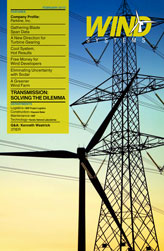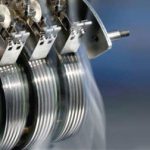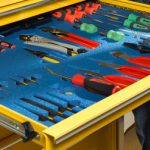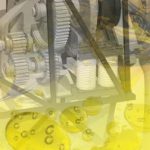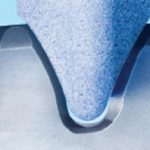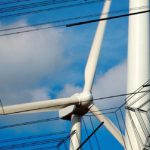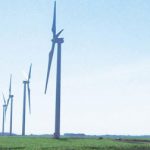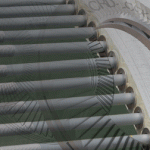Experiencing growth of some 30 percent per year, wind power manufacturing is undergoing an evolution. With several components being machining intensive, many processes are being reviewed, and new players from other manufacturing areas are bringing fresh ideas to how components can be made.
With gears being such an integral part of wind power generation, gear cutting is one of several component areas that are benefiting from new developments in machining technologies. Tool developments and design improvements that have been taking place for many years in other areas of manufacturing are now also benefitting the practice and performance of gear cutting.
Meeting Challenges
Wind power has to have gears and gearboxes, which means that a somewhat conservative industry is being challenged by new demands. With smaller component volumes for a new range of gears, even machinery is being reconsidered. Five-axis machining centers with new software are flexible enough to make different components—including gears, and even spiral bevel gears—to high accuracy. Although machining times are slower than those achieved with dedicated gear-cutting machines, setups are fast and the machines can also be used for machining related parts for gears, as well as other components for wind applications. This makes machining centers attractive for small- to medium-sized series of gears. These types of machines are also what machine shops entering the wind manufacturing market already have in place. Fig. 1
To a growing extent, gear cutting for wind power is thus becoming a mix of the established, dominated by dedicated gear-cutting machines mostly using solid cutters, and the new, with a combination of different methods and equipment. Gear hobbing dominates as the method to efficiently machine gears, but with the growth of wind power a new mix of external and internal gears is needed, from large slew rings to smaller conventional gearbox wheels. This has made gear milling with single or duplex cutters and hobs that employ indexable inserts or blades an interesting alternative, and it is here that today’s developments are making a difference in the economics of manufacturing.
Intensive Components
There is a leap in technology now occuring, where the recent tooling developments from other manufacturing areas are providing positive results for gear milling. Driven by competitiveness and the need for increased capacity, new modes of thinking with room for new tooling concepts have become a necessity in situations where parts require a lot of machining.
Large volumes of chips are generated in gear machining, with around 90 percent of the manufacturing processes involving metal cutting. This provides a huge potential for improvements in both productivity and production security, as well as quality consistency. The main driving trends in gear milling for wind-power components are: a move from solid cutters to indexable insert cutters; escalating cutting data, and a decrease in the use of coolant; growing application of disc cutters and hobs that can employ more effective teeth; the increasing use of duplex-type milling cutters and; one cut to an increasing extent replacing two cuts with a tool. Fig. 2
Solid cutters, usually ground and in high-speed steel, have dominated much of gear cutting, and they have the advantage of producing gears to within high tolerances. Their downsides, even after considerable tool material and coating development, is that machining rates are limited, durability is lower compared to cemented carbide, and there is a heavy reliance on the use of coolant. Generally, high-speed steel tools have a marginal application area in today’s overall machining, and the share of gear cutting tools they hold is shrinking.
Cementing Concerns
Cemented carbide has a very advantageous combination of wear resistance and toughness, a combination which has been dramatically improved upon through the development of coated indexable inserts. Since coated inserts were introduced for milling during the eighties, research and development has made advantageous new means available for the large range of different milling operations and workpiece materials. During the past few years a completely new insert generation has been introduced for milling, built on new developments of insert substrates, coating materials, coating manufacturing, and post processes. There is no doubt that machine shops involved in most types of industry stand to benefit from adopting this new generation of inserts.
For many years coated inserts were dogged by cutting edges that, by necessity, were relatively blunt. The nature of the edge line was such that, if thicker multicoating layers were to be applied and then function, the edge radius on the insert had to be comparatively large. This phenomenon is outdated, to a large extent, in that both substrate and coating technology has moved on. New PVD-coated (physical vapour depostition) inserts have sharp, positive cutting edges with high edge-line toughness. Also, the original CVD-coating (chemical vapour deposition) that brought high wear resistance through chemical and thermal wear resistance to inserts with high insert-bulk toughness have been developed intensively, and in some application areas the two types of coated insert grades overlap and complement each other. Fig. 3
New Insert Generation
Two new-generation coated cemented carbide grades for indexable inserts in milling cutters have proved especially adaptable for gear milling. Large cutter diameters with many teeth used in alloyed steels of varying hardness need the right type of toughness, complemented by suitable wear resistance, to optimize an application. Gear milling creates it own type of toughness demands, in addition to that of the workpiece material, in that radial depths of the cuts are small, and cutter diameters are large. One PVD-grade GC 1030 and one CVD grade GC4240—both developed for high-performance steel milling with different cutter types—are now proving to be performance raisers for gear milling, with or without coolant. Depending upon the application and manufacturing priorities involved, these grades can be applied in order to:
• Raise cutting data;
• Lengthen tool life;
• Provide predictable durability for maintaining set quality levels;
• Secure continuous reliable machining, and;
• Reduce the per-piece cost of manufactured gears.
New technologies are entering the growing area of gear cutting, prompted by the requirements of the wind-power industry. The development of machine tools toward higher spindle speeds, and thus cutting speeds, in combination with higher stability, have opened up, allowing for cemented carbide to play a larger role. For many years tool developments have continually resulted in higher performance and lower machining costs in machine shops involved in aerospace, power generation, automotive, machinery, medical, and most other types of general manufacturing. Solutions for gear cutting dominated by solid cutters in dedicated machinery have been on the periphery of tool development. Today, with changing manufacturing patterns and broader product ranges, new tool concepts and methods are being introduced for gear cutting.
Cutting-Edge Tools
In addition to new gear-milling insert grades, special gear cutting disc milling cutters have been designed with newly developed gear flank and top indexable inserts. Inserts are being based on new insert-seat technology that locates and retains the insert in position, thus adding accuracy and security to the process. New duplex cutters with indexable inserts for simultaneous milling of two gear teeth for internal gear milling are raising roughing performance dramatically, as is the use of round insert milling cutters.
Based on long experience in developing and applying segment-based tools for crankshaft milling, cutters with segments holding new inserts will be introduced for disc and duplex cutters. Furthermore, for hobbing, solid cutter bodies with full-profile insert, along with segment hobs with tangentially mounted inserts, will provide a means of higher metal removal rates with long tool life. Also, new developments for cutting splines, gear racks, key slots, and for profile milling are taking place that will bring new levels of machining to gear cutting. Moreover, the finishing capability of indexable insert tooling is improving distinctly.



















